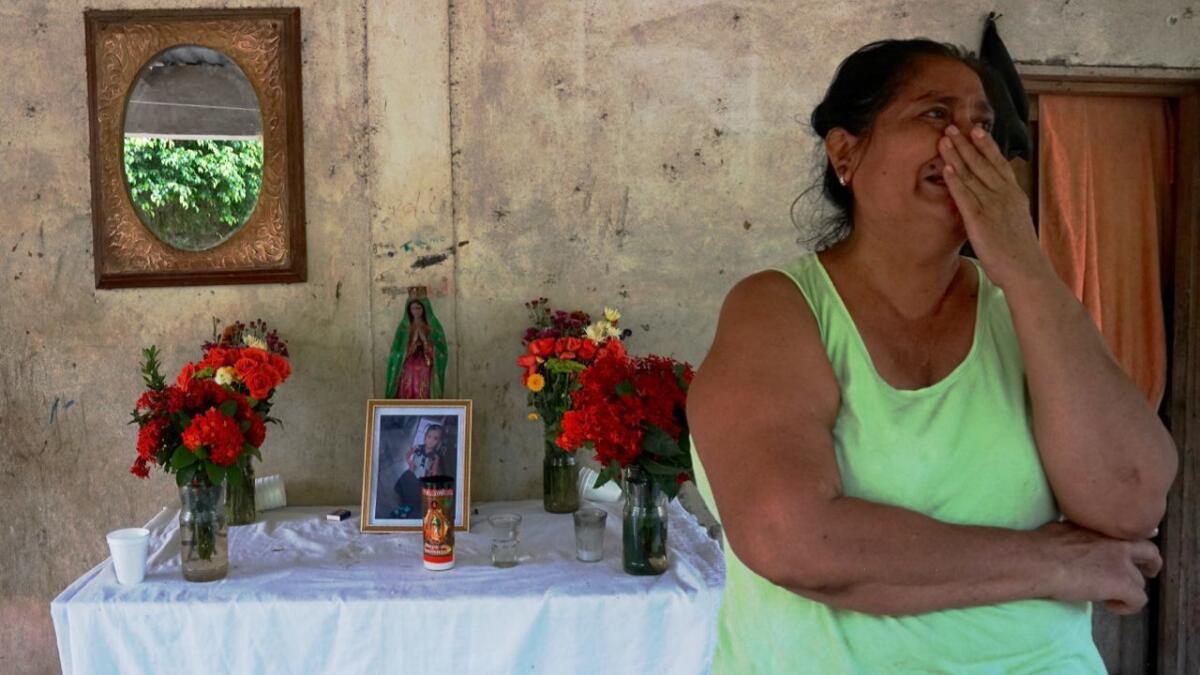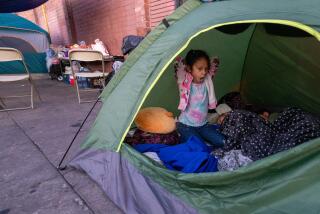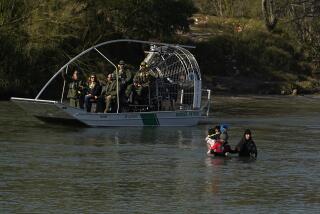Death at the border: 4 from Guatemala, 3 of them children, succumb to heat in Texas

Her sister had made the trek last year, following a familiar script: Cross into U.S. territory from Mexico with a minor child, surrender to the Border Patrol, and apply for political asylum — then get released and launch a new life in the United States.
Briseyda Lisseth Chicas Perez, 20, a one-time hometown beauty queen known for her buoyant personality, headed north last month with her husband and their two small children. They traveled more than 1,000 miles overland through their native Guatemala and Mexico to the Rio Grande.
But once they reached the border, things went tragically awry, one of a series of recent calamities involving U.S.-bound migrant families that have highlighted the perils — especially for children exposed to risks once largely undertaken by single men.
On June 23, Border Patrol agents found the bodies of Chicas Perez and her 18-month-old son, Denilson, along with the remains of two other children, in the brush just north of the Rio Grande outside McAllen, Texas. Two other mothers survived, but their children perished. All were Guatemalans and had crossed the river together four days earlier, relatives said.
Authorities suspect that the mothers got lost in the unforgiving terrain while looking to turn themselves in to the Border Patrol and that Chicas Perez and the children succumbed to dehydration and exposure in the searing South Texas heat.
“My daughter’s child died in her [mother’s] arms,” said Celia Alicia Ochoa Aguilar, whose daughter, Neily Yoseli Aguilar Ochoa, 34, a mother of three, was one of the two survivors.
Aguilar Ochoa’s youngest, Juana Anastasia Miranda Aguilar, 3, was among the three dead children, along with Marleny Mereidy Rivera Reyes, 20 months, and Denilson.
In the nearby farming hamlet of Valle Liro, relatives learned of a telephone call that Aguilar Ochoa — speaking from her hospital bed in Texas — made to a brother in the United States, describing how her daughter died. As she provided the details, she burst into tears, unable to continue talking, they said.
The tragedy has been overshadowed by another one that drew attention because of a dramatic image: the drowning deaths in the Rio Grande of a man from El Salvador and his daughter, age 23 months.
A photograph of the drowned Salvadorans — the girl with her arm draped around her father’s back in a final embrace along the river’s muddy banks — focused global attention on Central American migrants seeking asylum in the U.S. Their bodies were found a day after the Guatemalans’ remains were discovered.
No news photographer documented the grisly scene of the four deaths across the Rio Grande from Reynosa, Mexico, and relatives in both Guatemala and the United States have been left in distress and confusion. No one has told them when the bodies will be repatriated.
“We haven’t heard anything, only that my daughter and my little grandson are gone,” said Ofelia Perez, mother of Briseyda Chicas Perez, sobbing inconsolably on the shaded patio of her home here, as chickens squawked and neighborhood women prepared tamales and rice for visitors bearing condolences. “I pleaded with my daughter not to go. We knew of the dangers. But she insisted: ‘Mama,’ she said, ‘We have many needs. I want to help you and my little sister.’ ”
Briseyda’s sister, Asly Michel Chicas Perez, 6, who remained at home here, has a heart condition that requires monthly medical visits, straining a family budget sustained by cash sent by two other adult children already settled in the United States.
Nobody knows, either, what will become of the two surviving women who lost their children and face possible deportation back to Guatemala. The women were taken into U.S. custody and hospitalized, according to the Guatemalan foreign ministry. Families say both women have recuperated physically but are emotionally devastated.
U.S. immigration authorities and the FBI — which is investigating the case because the bodies were found on federal land — declined to comment on the status of the women.
Relatives said both survivors would prefer to remain in the United States, where their husbands now reside — and where one, Aguilar Ochoa, who lost her daughter, has an 11-year-old son in Kansas City with her husband. The other survivor, Yaquelin Mereidy Reyes Sopon, 19, who lost her only child, was headed to California, where her husband lives.
His daughter was 3 months old when he left for the north, never to see her again.
The deadly border incidents dramatize how the current wave of Central American family emigration leaves children especially vulnerable.
Migrants are packing kids into smuggling vans and trailers; harnessing them atop freight trains; leading them across the Rio Grande in rickety craft; or guiding them on foot in hot, remote zones of the U.S. Southwest, where hundreds of migrants perish each year.
Multitudes of Central Americans have weathered the risks and resettled in the United States in recent months, pending court hearings on their petitions for political asylum. But a Mexican crackdown responding to pressure from the Trump administration has left thousands stranded along Mexico’s southern and northern frontiers.
For Chicas Perez and her husband, bringing their two children meant keeping their family intact, easing the wrenching divisions that inevitably mark emigration. But the children’s presence also served a practical purpose: a hedge against long-term detention in the United States, where laws generally bar holding minor migrants for protracted periods — a practice that Trump has denounced as “catch and release.”
Throughout Central America, word has spread that traveling with minor children, surrendering to U.S. border agents and filing for political asylum can amount to a ticket to a new life.
“You hear that with children, it’s very easy to cross,” said Ofelia Perez, at home in this sweltering lowland expanse near the Pacific in western Guatemala.
All four victims hailed from this tropical agricultural region, home to vast banana and palm oil plantations serving the export market and multinational food conglomerates. Farmhands toil dawn to dusk for the equivalent of about $12 a day in the fields of wealthy landowners. This is another world from the postcard Guatemala of azure lakes, towering volcanoes and handicraft stands.
Emigration to the United States has long provided an economic alternative here, as in other areas of Guatemala, and is often idealized in lore that glosses over the difficulties and dangers — including predation by Mexican gangs and smugglers, often in cahoots with cops. The Guatemalans paid the going smuggler’s fee of of about $2,500 per person to be transported through Mexico to the U.S. border, relatives said. At least one family used their home as collateral, a not-uncommon practice in an area where emigration is viewed by many as the only means for advancement.
“People here have a lot of misconceptions about life on the other side, about how hard life can be there, about risks one can be exposed to going north,” said Julio Perez, as he sat in the family home’s dirt-floor patio comforting his sister, the distraught Ofelia Perez, while others rested in hammocks.
Briseyda was a favored niece. Relatives display a photo album featuring Briseyda as a beauty queen in Buenos Aires, her family’s neighborhood in the village of Chiquirines, part of the sprawling rural municipality of La Blanca.
“Briseyda was always smiling, always cheering people up,” said the uncle, who lived in the United States for three years, working in chicken-processing plants in Missouri.
For much of her life, she had been exposed to the lure of the north.
A brother, 26, has been in the United States for five years but remains undocumented, the family says. Her elder sister left last year with her 6-year-old son, and is now in Missouri with their brother.
“My other daughter made it in five days,” said Ofelia Perez, who added that she herself had resisted entreaties to head north with her ailing 6-year-old daughter.
Ofelia Perez recalled a recent telephone conversation in which Briseyda told her sister in the United States: “You crossed easily, so I’m going too!”
Her in-laws were also a powerful draw. They live in Kansas, where she, her husband and two children were headed.
Once at the border, relatives said, the husband successfully crossed the Rio Grande first with the couple’s 3-year-old daughter, Ingrid Alondra.
Many U.S.-bound migrant families split up at the border and cross separately, dividing the children between parents. The strategy is meant to lessen the chances that both parents are detained.
Chicas Perez crossed the Rio Grande on the midafternoon of June 19, relatives say. Accompanying her on a smuggler’s craft, relatives here say, were her son and the two women who ultimately survived the ordeal, each with a child of her own.
What happened in the days between the successful river crossing into U.S. territory and the discovery of the bodies remains unclear. But the three mothers, left alone in parched terrain with their children, clearly faced extreme conditions.
Here in Guatemala, relatives have set up flower-bedecked memorials at their homes, displaying candles, photos and other mementos. A glass of water sits on each altar, emblematic of the victims’ forlorn efforts to quench a life-sapping thirst.
“The water is for my sister and my nephew,” explained Saydy Chicas Perez, another sister of Briseyda who remains at home here with her family. “That they never lack for a drink again.”
Special correspondents Liliana Nieto del Rio in La Blanca and Claudia Palacios in Guatemala City, Times staff writer Molly Hennessy-Fiske in Houston, and Cecilia Sanchez of The Times’ Mexico City bureau contributed to this report.
Twitter: @PmcdonnellLAT
More to Read
Start your day right
Sign up for Essential California for news, features and recommendations from the L.A. Times and beyond in your inbox six days a week.
You may occasionally receive promotional content from the Los Angeles Times.






